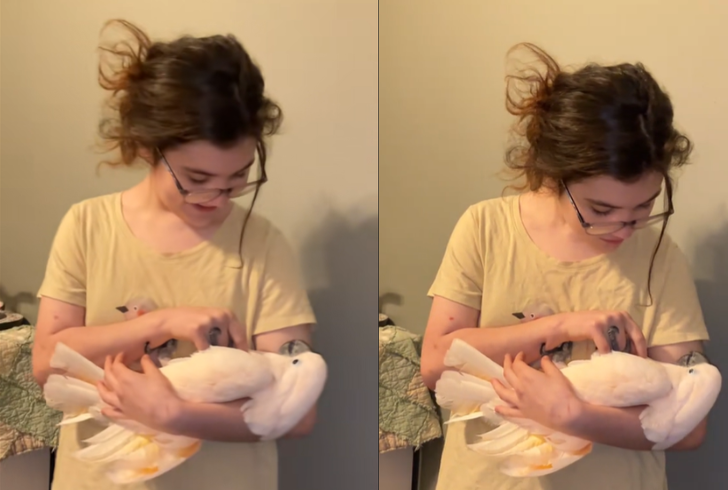Teen Comforts 27-Year-Old Cockatoo After Nightmare and It’s Melting Hearts
Sometimes, the most meaningful moments don’t make a sound. A teenager is seen gently soothing a 27-year-old cockatoo named Pudge, who’d just woken from what seemed to be a nightmare. Birds like Pudge—especially those with a rough start in life—often carry trauma in ways we don’t always recognize. They don’t bark or whimper. They just… endure.
As the video begins, Pudge sits calmly, cradled softly while his human rocks him back and forth. The caption reads, “Loving a rescue bird means dealing with nightmares sometimes. You’re home, Pudge, and you won’t return to that life ever again. It’s a straightforward statement, but it conveys everything.
Birds like Pudge don’t always show their past pain right away. In fact, many rescue birds develop symptoms of post-traumatic stress, just like humans. Whether it’s from neglect, loud environments, or isolation, trauma takes root in different ways. Some birds bite. Others pluck their feathers or stay quiet for long periods.
As this heart-melting clip made its way online, viewers quickly shared their emotions. One person wrote, “The fact that they have nightmares from prior trauma makes my heart shatter into a million pieces.”
Another comment echoed similar thoughts: “They’re so beautiful—why would anyone mistreat them? So glad he’s finally safe.”
Birds with PTSD need more than just space and food. They need patience, consistency, and calm. Unlike other pets, parrots and cockatoos form deep emotional bonds. So when they feel safe, their entire behavior begins to shift.
How to Help a Traumatized Bird Feel Safe
Settling a bird that’s been through trauma isn’t just about waiting. It’s about how you show up, day after day. Speak to them gently, with a steady tone. Move slowly, and keep their space free of sudden noise or clutter.
Find a quiet corner for the cage, where life doesn’t come at them all at once. Inside, make it feel safe—think covered edges, a soft perch. And at night, tone down the brightness so they can rest without added tension.
Bird Supplies notes that many birds show signs of trauma not unlike humans—startle responses, withdrawal, even anxiety that spikes without warning. The goal isn’t to rush healing, but to make peace feel like a default again. When caretakers learn to notice these signs early, they can respond with the right support.

TikTok | @pudgethecockatoo | Pudge’s short story powerfully illustrates how kindness and calm mend trauma-shattered safety.
Veterinarians often recommend creating a peaceful routine. Feeding your bird at the same time each day, keeping the atmosphere low-key, and watching for any shifts in behavior might seem small, but these patterns build a foundation of trust.
Birds notice what repeats. They settle into rhythms. If something feels off or if stress symptoms spike, don’t hesitate to check in with a vet. It’s better to catch something early than wonder later.
Pudge’s story isn’t long, but it lingers. The care shown to him—the slow rebuilding of safety—is where the meaning lives. Healing doesn’t need to be dramatic. Sometimes it’s just a quiet presence. A calm space. A reminder that fear doesn’t have to be permanent.